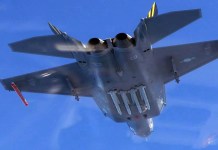To counter Chinese air defenses in Ladakh and other bordering areas, India has decided to fast-track its swarm drone system, similar to the ones deployed by the rival country on the other side of the border, Indian media reports.
Afghanistan, The Graveyards Of Super Powers – Will China Be Next In The Firing-Line?
The development of the air-launched swarm drone system is being accelerated to reduce the vulnerability of the Indian fighter jets to ground-based air defenses, The Economic Times said.
Indian defense companies are reportedly contemplating using the Indian Air Force’s (IAF) Jaguar land-attack fighter to launch up to 24 killer drones to take down individual targets inside enemy territory, the report added. The country’s artificial intelligence agency has been tasked to develop AI capabilities for the drones for target acquisition.
Although India has been quickening the pace towards developing indigenously built autonomous systems for many years now, the recent developments on the border with China have pushed the armed forces to remain prepared for all eventualities.
China’s Advanced Weaponry
China has deployed advanced weaponry, which includes tanks, helicopters, and high-tech drones, in Ladakh, especially the S-400, which is said to give the country the advantage in high-altitude conflicts, should they arise.
The state-owned Global Times had recently reported that since the Doklam standoff with India in 2017, the Chinese military had expanded its drone deployments such as GJ-2, which should give it an edge over India.
Being the biggest manufacturer and exporters of UAVs, China’s widely used UAV, the GJ-2 strike model is an 11-meter long medium-altitude long-endurance (MALE) drone with a payload of 480kg.
It can carry up to 12 missiles or bombs, has a top speed of 380km/hour, a cruising speed of 200km/hour, and a service ceiling of 9,000 meters. The country is said to have recently sold 48 of these attack drones to Pakistan under the export brand name, Wing Loong II.

However, the new initiative by India is to use drone swarms to destroy the enemy’s air defenses before they could pose any threat to the fighter aircraft. The UAVs are both cheap and hard to detect, compared to fighter jets, an advantage that is now being recognized worldwide by many countries.
The project, to be undertaken by the IAF, involves two startups and the state-owned Hindustan Aeronautics Limited (HAL). It is set to take four years for the country’s armed forces to finally get hold of the swarm drone systems and involves the development of four individual systems, which are already being designed, as per the report.
The plan envisages using the Jaguar land attack aircraft as the mothership, which will release the four pods, each carrying six hunter-killer drones launched towards the target. The aircraft is being modified to allow for such an arrangement to take place. Each of the individual drones will then proceed to the target autonomously while the aircraft stays out of the range of the enemy air defenses.
Also being designed is the very high altitude, long-endurance (VHALE) unmanned aircraft, which will not only monitor the system itself but keep an eye on adversary positions while staying at dizzying heights of 70,000 feet.
Not much is known about India’s VHALE development, although at least 20 companies had demonstrated their capabilities to develop such systems last year, which the IAF wants to use mainly for human assistance and disaster relief (HADR) and real-time intelligence-gathering purposes, but may weaponize them as well.
India’s worries increased when China deployed its Russian-acquired S-400 air defense system in Aksai Chin, the area where the two countries are locked in a conflict for months now.
This could severely hamper India’s air penetration through the area, and as such cheaper alternatives are being sought to counter such air defenses, and the attack drones could achieve such a mission. That explains the urgency of the current initiative to bolster the attack drone offensive against Chinese defenses.
India Has A Long Way To
Currently, India does not possess attack drone capabilities, and the country has a long way to go with its primary UAVs (the Israeli Searchers and Herons), with its few indigenously developed UAVs continuing to perform badly due to lack of technology.
China Ends Western Nuclear Monopoly With Indigenous Hualong One Reactor – Chinese Media
India in 2019 had announced that it was jointly pursuing the development of swarm drones and anti-drones systems with the US, under their Defense Technology Trade Initiative.
Recently, the country inducted two American drones — MQ-9 Sea Guardian, the unarmed Predator-B — into the Navy on lease under the emergency procurement in the backdrop of the tensions with China in Ladakh.
The indigenous Rustom-2 medium altitude long endurance program was also given precedence recently after the conflict with China worsened, however, it may take many years to actually be operational with the armed forces. A prototype of the drone tested this year achieved eight hours of flying at an altitude of 16,000 feet, although it is expected to reach up to 26,000 feet and endurance of 18 hours by 2020 end.
While India’s DRDO, along with HAL, has already developed many other UAVs, such as Lakshya and Nishant, besides the indigenous MALE drone Rustom, they seem incapable of giving the country a decisive edge over the technologically-superior adversary.
However, the country’s private companies, such as the Bengaluru-based start-up, New Space Research and Technologies, are also working along with HAL to develop its own drone swarm technology project, called the ‘Air-Launched Flexible Asset-Swarm’ (ALFA-S).
The ALFA-S drones are expected to be 1-2 meters long with folding wings, capable of being packed in canisters and launched from aircraft. The first prototype is expected to be completed within two years.
Considering India will be pitted against mighty China, whose swarm technology has even outflanked the US’ in some aspects, the Indian side will have much work to do in the coming years. The Chinese military understands the potential of drone swarms in offensive roles and has been amassing hordes of such systems on the border with India.




